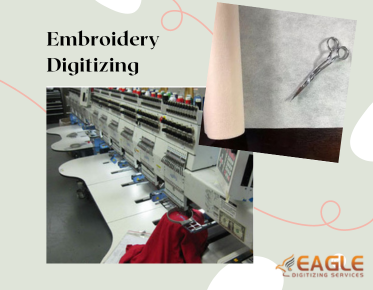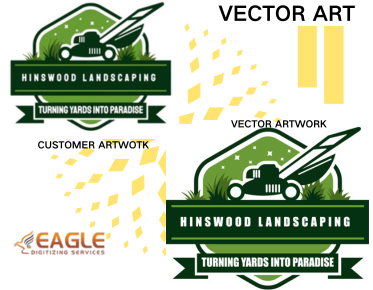Hooping and Stabilizers: Key to Perfect Embroidery/Eagle Digitizing
Embroidery is a beautiful blend of artistry and craftsmanship. However, achieving those perfect stitches isn't just about skill and creativity; it also hinges on the right tools and techniques. Two key components that significantly influence the outcome of your embroidery are hooping and stabilizers. These often-overlooked essentials can make the difference between a masterpiece and a muddled mess. For the best digitizing service, please feel free to contact us.
The Importance of Hooping and Stabilizers in Embroidery
Hooping and stabilizers are the unsung heroes of embroidery. Proper hooping keeps your fabric taut and prevents movement during stitching, ensuring your design stays aligned and precise. Stabilizers, on the other hand, provide the necessary support to your fabric, preventing puckering, and distortion, and ensuring clean, crisp stitches.
What is Hooping?
The Basics: What Does Hooping Mean in Embroidery?
Hooping involves securing the fabric in a frame, known as a hoop, to keep it taut and stationary while you stitch. This tension is crucial for maintaining the accuracy and consistency of your embroidery design.
History of Hooping: From Hand-Held to Modern Hoops
Hooping has evolved from simple hand-held frames used centuries ago to the sophisticated, adjustable hoops we see today. Early hoops were often made from wood and required significant manual adjustment. Modern hoops, made from durable materials like plastic and metal, offer enhanced stability and ease of use.
Types of Hoops
Standard Hoops: The Go-To Choice
Standard embroidery hoops are versatile and commonly used for a variety of projects. They come in various sizes and materials, making them suitable for both beginners and experienced embroiderers.
Spring Tension Hoops: For Delicate Projects
Spring tension hoops are perfect for delicate fabrics that need gentle handling. These hoops use a spring mechanism to hold the fabric in place without applying excessive pressure, preventing damage to the material.
Magnetic Hoops: The Modern Marvel
Magnetic hoops are a game-changer for many embroiderers. They use powerful magnets to secure the fabric, allowing for easy adjustments and repositioning without removing the fabric from the hoop. This makes them ideal for intricate and multi-hooping projects.
Hoops for Specialized Projects: When to Use What
Specialized hoops cater to unique embroidery needs. For instance, cylindrical hoops are great for embroidering on sleeves or pant legs, while large hoops accommodate big designs or quilt blocks. Choosing the right hoop for your project ensures optimal results.
Selecting the Right Hoop for Your Project
Matching Hoop Size to Embroidery Design
The size of your hoop should match the dimensions of your embroidery design. A hoop that's too small can distort your fabric, while one that's too large might not provide the necessary tension.
Fabric Considerations: Choosing Hoops for Different Materials
Different fabrics require different types of hoops. Delicate fabrics like silk or chiffon benefit from spring tension hoops, while sturdy materials like denim or canvas work well with standard or magnetic hoops.
Budget-Friendly vs. Premium Hoops: What to Consider
While premium hoops offer enhanced features and durability, budget-friendly options can also deliver satisfactory results. Consider your project needs, frequency of use, and budget when choosing between these options.
Hooping Techniques
The Traditional Method: Step-by-Step Guide
1. Lay your fabric over the inner hoop.
2. Place the outer hoop on top and press down firmly.
3. Tighten the screw or adjust the clamp until the fabric is taut.
4. Ensure the fabric is evenly stretched with no wrinkles or slack.
The Floating Method: When and How to Use It
The floating method is used when you can't hoop your fabric directly, such as with thick or bulky materials. Secure a stabilizer in the hoop and then adhere the fabric to the stabilizer using temporary adhesive spray or pins.
Tips for Avoiding Common Hooping Mistakes
Avoid over-tightening the hoop, which can cause fabric distortion. Ensure your fabric is centered and straight to prevent skewed designs. Regularly check for slack during stitching to maintain tension.
What are Stabilizers?
Introduction to Stabilizers: Why They’re Essential
Stabilizers are materials placed behind or in between your fabric to provide extra support during embroidery. They help maintain fabric structure, prevent stretching, and ensure clean, precise stitching.
The Role of Stabilizers in Achieving Perfect Stitches
Stabilizers are crucial for achieving perfect stitches, especially on stretchy or delicate fabrics. They prevent puckering and distortion, allowing your embroidery to lay flat and maintain its intended shape.
Types of Stabilizers
Cut-Away Stabilizers: For Permanent Support
Cut-away stabilizers provide long-lasting support and are ideal for designs with high stitch counts. After embroidery, the excess stabilizer is trimmed away, leaving the remaining material to support the stitches permanently.
Tear-Away Stabilizers: Easy Removal for Light Fabrics
Tear-away stabilizers are great for light to medium-weight fabrics. They provide temporary support during stitching and can be easily torn away after the design is complete.
Wash-Away Stabilizers: Perfect for Delicate and Sheer Fabrics
Wash-away stabilizers dissolve in water, making them ideal for delicate and sheer fabrics where leftover stabilizers would be visible or undesirable. They are perfect for lace, cutwork, and other intricate designs.
Fusible Stabilizers: When Extra Adhesion is Needed
Fusible stabilizers have an adhesive backing that can be ironed onto the fabric. This extra adhesion is beneficial for stretchy or slippery fabrics, ensuring the stabilizer stays in place during stitching.
Choosing the Right Stabilizer
Matching Stabilizer to Fabric Type
Different fabrics require different stabilizers. For example, stretchy fabrics need a cut-away stabilizer for lasting support, while lightweight fabrics work well with tear-away options.
Stabilizers for Different Embroidery Techniques
Consider the embroidery technique when choosing a stabilizer. Heavy stitching or dense designs need more robust stabilizers, while lighter, open designs can use thinner, less intrusive options.
Balancing Stability and Flexibility: Key Considerations
The right stabilizer provides enough support without making the fabric too stiff. Balance is key: too much stability can make the fabric rigid, while too little can result in puckering and distortion.
How to Use Stabilizers
Preparing Your Fabric and Stabilizer
Prepare your fabric and stabilizer by cutting them to the appropriate size. Ensure the stabilizer extends beyond the embroidery area to provide adequate support.
Proper Application: Avoiding Shifts and Wrinkles
Secure the stabilizer to the fabric to avoid shifting during stitching. Use temporary adhesive spray or baste the stabilizer in place to prevent wrinkles and movement.
Tips for Removing Stabilizers Without Damaging Fabric
Remove stabilizers carefully to avoid damaging the fabric. For cut-away stabilizers, trim close to the stitches without cutting them. For tear-away and wash-away stabilizers, follow the manufacturer's instructions for removal.
Common Hooping and Stabilizer Problems
Hoop Burn: Causes and Solutions
Hoop burn occurs when the hoop leaves an impression on the fabric. To prevent this, use a light touch when hooping and avoid over-tightening. If hoop burn occurs, gently steam the fabric to remove the marks.
Stabilizer Show-Through: How to Avoid It
Stabilizer show-through happens when the stabilizer is visible through the fabric. Use a lighter-weight stabilizer or a wash-away option for sheer fabrics to prevent this issue.
Dealing with Fabric Distortion: Tips and Tricks
Fabric distortion can be avoided by ensuring proper hoop tension and using the right stabilizer. If distortion occurs, gently press the fabric to restore its shape.
Advanced Hooping Techniques
Multi-Hooping: For Larger Designs
Multi-hooping is used for designs larger than your hoop. Mark your fabric to align the design sections accurately and re-hoop as needed to complete the entire design seamlessly.
Continuous Hooping: Creating Seamless Patterns
Continuous hooping allows you to create seamless patterns over a large area. Carefully align each hooping to maintain the pattern's continuity.
Using Hoop Templates for Precision Placement
Hoop templates help with the precise placement of your designs. They ensure your design is centered and positioned exactly where you want it on the fabric.
DIY Hooping and Stabilizer Hacks
Homemade Hoops: Crafty Alternatives
In a pinch, you can create your own hoops using materials like embroidery frames or sturdy cardboard. These homemade solutions can work for small, simple projects.
Budget-Friendly Stabilizer Options: What Works and What Doesn’t
Budget-friendly stabilizer alternatives include using coffee filters, dryer sheets, or even lightweight interfacing. While not ideal for all projects, they can work for light, non-stretch fabrics.
Maintaining Your Hoops and Stabilizers
Cleaning and Care Tips for Longevity
Keep your hoops clean by wiping them with a damp cloth after use. Avoid exposing them to extreme temperatures or moisture to prevent warping. Store stabilizers in a dry, cool place to maintain their adhesive properties.
Proper Storage: Keeping Your Tools in Top Shape
Store your hoops flat or hanging to avoid warping. Keep stabilizers rolled or flat to prevent creases and ensure they are ready for use when needed.
Innovations in Hooping and Stabilizers
The Latest in Hoop Technology: What’s New?
Recent innovations in hoop technology include magnetic hoops and adjustable tension systems, which provide better fabric control and ease of use. These advancements make hooping faster and more precise.
Eco-Friendly Stabilizers: Sustainable Options
Eco-friendly stabilizers made from biodegradable materials are gaining popularity. These sustainable options reduce environmental impact while still providing excellent support for your embroidery projects.
Expert Tips and Tricks
Professional Insights: Hooping Like a Pro
Professionals recommend always using the right size hoop for your design, ensuring even tension, and regularly checking your fabric during stitching to avoid slack.
Common Myths About Hooping and Stabilizers Debunked
Contrary to popular belief, more stabilizer isn't always better. Eagle Digitizing offers professional embroidery digitizing services. Using the right type and amount for your fabric and design ensures optimal results without unnecessary bulk.
Mastering hooping and stabilizers is essential for embroidery success. These tools ensure your designs are precise, professional, and durable, elevating your embroidery projects. Future trends in hooping and stabilizers include continued advancements in technology, such as more efficient hoop designs and eco-friendly stabilizers, making embroidery easier and investing time in learning proper hooping and stabilizer techniques pays off with superior embroidery results. These foundational skills elevate your work, allowing you to create stunning, professional-quality designs.



